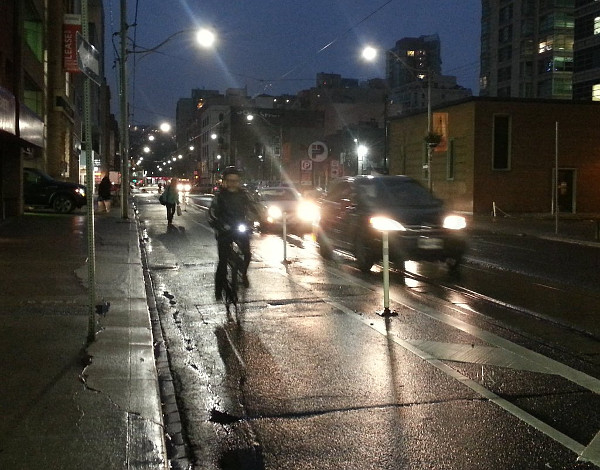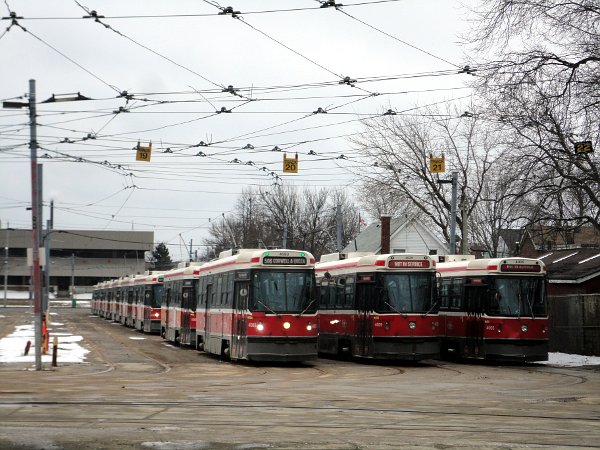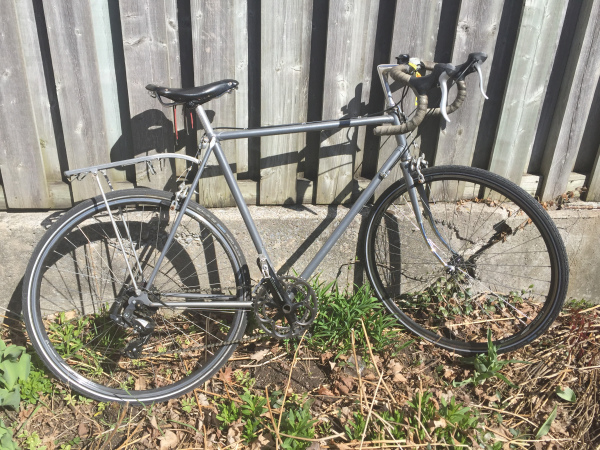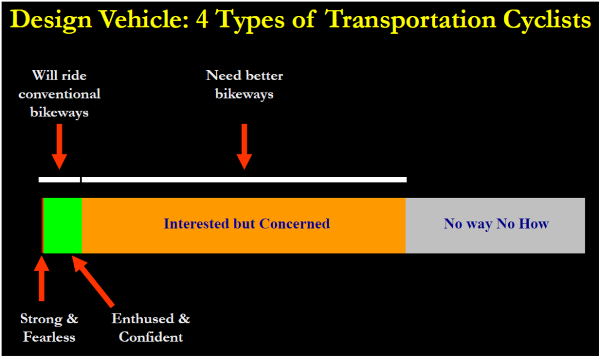Providing safe infrastructure for cycling gives people the freedom to choose how they get around, whereas maintaining road space solely for the use of cars traps people into one mode of transportation.
By Justin Jones
Published February 24, 2016
This article has been updated.
Knowing what I do for a living, people often ask me how I got to this point. Did I grow up in Amsterdam, Portland or Montreal? Were my parents hippies who got around by bike? Have I received a driving ban for some taboo reason, and am now forced to rely on other modes of transportation?

Person riding a bicycle on Adelaide Street, Toronto (RTH file photo)
In fact, I grew up in Southern Alberta, in a town where turning 16 meant you faced a choice: either get your driver's license and get whatever vehicle you (or your parents) could afford, or enjoy your status as a social outcast. I opted for the first option, earning my driver's license at 16 years and two days old, immediately purchasing a 1984 Chrysler Fifth Avenue.
It was less of a car than it was two massive couches on wheels, but it got me around and provided the means for my friends and I to escape our town on a regular basis to head into the big city for the occasional movie or night on the town.
Once you had a car, bikes were something that kids used for fun, not a means of getting around. I can distinctly remember driving from my school to the convenience store down the street - a distance that Google Maps tells me is about 320 metres.
So no, I didn't grow up in Amsterdam. In fact, my late teens and early adulthood were spent in some of the most auto-centric places I've ever seen, even to this day - a place where people will literally drive from the grocery store to the post office - a trip of all of 75 metres.
Once I made it into University in Edmonton, things were close together and parking was expensive, so I left the old Fifth Ave at home. But it was always there during the summers, and my transportation habits didn't change much.
Sure, I walked a few more places while at University, but I never ventured far outside the University area bubble, unless it was to go to West Edmonton Mall, and that trip was often taken by car or, if I couldn't get a ride, by bus.

TTC streetcars in Toronto (RTH file photo)
I was playing in a band at the time, and our rehearsals and shows were about a 45 minute TTC ride away, depending on the traffic and how long you had to wait for the next streetcar or bus. One night it took me almost an hour and a half to get there, and that was when I decided, at age 23, to get back on a bike.
I was fortunate to live on St. George Street in Toronto, a relatively calm street with bike lanes on either side. Every day I watched a steady stream of cyclists going about their lives - heading to class, to work, to get groceries, and I thought to myself, "None of them are waiting 45 minutes for a streetcar!"
So the next week I went out and I bought myself a bike. It was an early 1990s Raleigh ten-speed hybrid - the perfect bike for someone wanting to commute around town without drawing too much unwanted attention to the bike. (This was back in the Igor Kenk days in Toronto, when bikes went missing even more than they do now.)
After a few shaky rides, I discovered that riding a bike was just like - well, you know. And before you knew it I was riding every day. What a difference it made.
I discovered Little Portugal, Corso Italia, The Beaches and many other areas I had only heard about. I frequented the areas I really liked more - I became a regular shopper in Kensington Market, Little Italy and Chinatown, where before I rarely had the time to walk all the way down to those areas.
I got to know shopkeepers, bartenders, baristas and servers all over the city, and I loved the feeling that came with knowing that I was getting to my destination faster than anyone else.
I regularly beat my friends who took taxis to our destinations, and unless it was a long journey along a subway line, I was always confident that I would always arrive before I would have if I had taken transit.

My Silver Peugeot - the second bike I ever bought, and the one I still rider today!
A side effect of all of this was that I was healthier than I had been in years as well. Just by building active transportation into my daily routine, I was thinner, fitter and happier than I had been in a long time.
Add all of these benefits to the $60 or so each month I was saving on transit, and it becomes pretty easy to understand why I grew to love my bike so much, and why I now work every day to share that joy with others.
While my story is certainly not unique, it is indicative of the transformational nature of active transportation, which is why I feel compelled to share it.
The only problem with my story is that most of the people that would tell you a similar story - someone who just one day decides to give this cycling thing a try - would have a great deal, at least from a demographic standpoint, in common with me, especially at the time I started riding.
More often than not they'd be male, 18-35 years old and likely wouldn't have children. They would likely fall into the least risk averse demographic, and often become the "one percent" of the cycling world - the strong, fearless riders who will ride anywhere in any conditions.
When cycling advocates talk about the different types of cyclists and potential cyclists, this is often the chart that gets brought up:

Four types of cyclists
While I previously would have put myself comfortably in the one percent category, I've moved out of my 20s and have added the responsibility of being a father - so I've found that I'm actually less willing to ride anywhere in any conditions.
I'm more careful about selecting my route, and my heart beats a little quicker when I'm on a busy street without bike lanes, even when I'm not riding any faster.
If someone like me, a 31-year-old who has been cycling for eight years in mixed traffic, isn't comfortable on those roads, what makes people think that the lack of cyclists means that there's a lack of demand?
It's a lot like looking at a raging river and saying, "Well, I don't see anyone swimming across it, so I suppose we don't need to build a bridge to the other side."
If you aren't seeing a large number of cyclists in your community, it's not because your residents are so exceptional that they will never get out of their cars if given other options.
In cities from Montreal to Phoenix and in smaller centres like Corvallis, Oregon and Boulder, Colorado and in hundreds of other communities all over the continent, people are proving that when safe cycling infrastructure is built, people exercise their right to choose how they move around, and start traveling via different modes.
In all my time working on cycling issues, I have yet to find a single community where a significant, sustained investment in cycling infrastructure has not yielded a significant increase in the number of cyclists.
Often the increases are much more significant than planners expected, further highlighting the pent-up demand for cycling all over North America.
Providing safe infrastructure for cycling gives people the freedom to choose how they get around, whereas maintaining road space solely for the use of cars traps people into one mode of transportation, forcing them to take on added expenses and often resulting in them using the wrong tool for the job when it comes to many trips.
I was fortunate enough to be able to make the choice - I had some infrastructure that made me feel safe, I'm an able-bodied, fit young man who is able to ride relatively quickly, and is brave (/stupid) enough to ride in mixed traffic.
But not many people fit that profile. And if we aren't thinking about how we can provide them with more of an environment of choice, then we're still practicing discriminatory transportation policies that rob people of the freedom to choose how they get around their community safely and effectively.
We need to restore that choice, and that means a serious re-think about how we use our road space.
Until then, enjoy the ride.
This article was first published on Justin Jones' personal website.
Update: the percentages on the chart of the four types of cyclists originally added up to more than 100%. RTH regrets the error.
By inthe6% (anonymous) | Posted February 24, 2016 at 13:32:42
Great article. Correction needed on pie chart...proportions look right but numbers add up to 106%.
By KevinLove (registered) | Posted February 24, 2016 at 19:25:26 in reply to Comment 116620
In my opinion, it is useful to put the percentage of the population onto the Portland graphic. After all, there is plenty of research verifying this model. The Portland model has been verified in cities ranging from London, England to Melbourne, Australia.
Also, I do not like the captioning on this graphic. Instead of, "Will ride conventional bikeways" I would write, "Will use unprotected infrastructure." It is highly inappropriate to use the word "conventional" to describe infra that violates the CROW engineering design manual for bicycle traffic. Violations of these established design engineering standards need to be correctly identified as engineering incompetence and/or negligence.
To quote from my own article, the percentages and their descriptions are:
The "Strong and Fearless." These are people who are willing to cycle without any cycling infrastructure. They are less than 1 percent of the population.
The "Enthused and Confident." These are people who are willing to cycle on unprotected cycling infrastructure. They are about 7 percent of the population, and are disproportionately men between the ages of 18-65.
The "Interested but Concerned." This is 60 percent of the population. They will only cycle on protected or car-free infrastructure.
The "No Way, No How." This is 33 percent of the population. These people just don't like cycling. They will only cycle on protected or car-free infrastructure AND cycling must be faster, easier and more convenient than alternate means of transportation. Many members of this demographic are willing to undergo considerable inconvenience to avoid cycling and take alternate methods of transportation.
By joejoe (anonymous) | Posted February 25, 2016 at 09:46:12
"I regularly beat my friends who took taxis to our destinations, and unless it was a long journey along a subway line, I was always confident that I would always arrive before I would have if I had taken transit."
I used to enjoy racing my wife's cab back after a night out in Toronto. I won every time ;)
"I'm more careful about selecting my route, and my heart beats a little quicker when I'm on a busy street without bike lanes, even when I'm not riding any faster."
After hitting my 40's and having kids I gave up unprotected streets like Queen and King. Even the new bike lanes on Adelaide need special care due to the lack of poles around corners (cars don't always look before they turn...). The safe routes I can take in Toronto are very limited. Until they get a fully segregated fully integrated network my heart will always be stopping at some point.
Thx for the article!
By Matt Pinder (anonymous) | Posted March 01, 2016 at 09:03:44
"It's a lot like looking at a raging river and saying, "Well, I don't see anyone swimming across it, so I suppose we don't need to build a bridge to the other side.""
Awesome quote! I can really relate to your story having grown up in a very similar situation myself. I hope that in the coming years more people are able to have those "aha" moments about cycling and realize its potential.
Thanks for the article!
You must be logged in to comment.
There are no upcoming events right now.
Why not post one?